Marc Pollefeys
Department of Computer Science, ETH Zurich, Switzerland and Microsoft Mixed Reality & AI Lab, Zurich, Switzerland
From Indoor to Open World: Revealing the Spatial Reasoning Gap in MLLMs
Dec 22, 2025

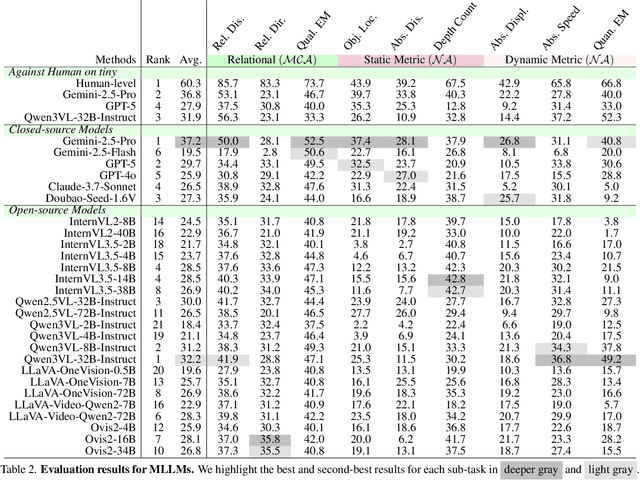

Abstract:While Multimodal Large Language Models (MLLMs) have achieved impressive performance on semantic tasks, their spatial intelligence--crucial for robust and grounded AI systems--remains underdeveloped. Existing benchmarks fall short of diagnosing this limitation: they either focus on overly simplified qualitative reasoning or rely on domain-specific indoor data, constrained by the lack of outdoor datasets with verifiable metric ground truth. To bridge this gap, we introduce a large-scale benchmark built from pedestrian-perspective videos captured with synchronized stereo cameras, LiDAR, and IMU/GPS sensors. This dataset provides metrically precise 3D information, enabling the automatic generation of spatial reasoning questions that span a hierarchical spectrum--from qualitative relational reasoning to quantitative metric and kinematic understanding. Evaluations reveal that the performance gains observed in structured indoor benchmarks vanish in open-world settings. Further analysis using synthetic abnormal scenes and blinding tests confirms that current MLLMs depend heavily on linguistic priors instead of grounded visual reasoning. Our benchmark thus provides a principled platform for diagnosing these limitations and advancing physically grounded spatial intelligence.
RocSync: Millisecond-Accurate Temporal Synchronization for Heterogeneous Camera Systems
Nov 18, 2025Abstract:Accurate spatiotemporal alignment of multi-view video streams is essential for a wide range of dynamic-scene applications such as multi-view 3D reconstruction, pose estimation, and scene understanding. However, synchronizing multiple cameras remains a significant challenge, especially in heterogeneous setups combining professional and consumer-grade devices, visible and infrared sensors, or systems with and without audio, where common hardware synchronization capabilities are often unavailable. This limitation is particularly evident in real-world environments, where controlled capture conditions are not feasible. In this work, we present a low-cost, general-purpose synchronization method that achieves millisecond-level temporal alignment across diverse camera systems while supporting both visible (RGB) and infrared (IR) modalities. The proposed solution employs a custom-built \textit{LED Clock} that encodes time through red and infrared LEDs, allowing visual decoding of the exposure window (start and end times) from recorded frames for millisecond-level synchronization. We benchmark our method against hardware synchronization and achieve a residual error of 1.34~ms RMSE across multiple recordings. In further experiments, our method outperforms light-, audio-, and timecode-based synchronization approaches and directly improves downstream computer vision tasks, including multi-view pose estimation and 3D reconstruction. Finally, we validate the system in large-scale surgical recordings involving over 25 heterogeneous cameras spanning both IR and RGB modalities. This solution simplifies and streamlines the synchronization pipeline and expands access to advanced vision-based sensing in unconstrained environments, including industrial and clinical applications.
YoNoSplat: You Only Need One Model for Feedforward 3D Gaussian Splatting
Nov 10, 2025Abstract:Fast and flexible 3D scene reconstruction from unstructured image collections remains a significant challenge. We present YoNoSplat, a feedforward model that reconstructs high-quality 3D Gaussian Splatting representations from an arbitrary number of images. Our model is highly versatile, operating effectively with both posed and unposed, calibrated and uncalibrated inputs. YoNoSplat predicts local Gaussians and camera poses for each view, which are aggregated into a global representation using either predicted or provided poses. To overcome the inherent difficulty of jointly learning 3D Gaussians and camera parameters, we introduce a novel mixing training strategy. This approach mitigates the entanglement between the two tasks by initially using ground-truth poses to aggregate local Gaussians and gradually transitioning to a mix of predicted and ground-truth poses, which prevents both training instability and exposure bias. We further resolve the scale ambiguity problem by a novel pairwise camera-distance normalization scheme and by embedding camera intrinsics into the network. Moreover, YoNoSplat also predicts intrinsic parameters, making it feasible for uncalibrated inputs. YoNoSplat demonstrates exceptional efficiency, reconstructing a scene from 100 views (at 280x518 resolution) in just 2.69 seconds on an NVIDIA GH200 GPU. It achieves state-of-the-art performance on standard benchmarks in both pose-free and pose-dependent settings. Our project page is at https://botaoye.github.io/yonosplat/.
Scaling Image Geo-Localization to Continent Level
Oct 30, 2025Abstract:Determining the precise geographic location of an image at a global scale remains an unsolved challenge. Standard image retrieval techniques are inefficient due to the sheer volume of images (>100M) and fail when coverage is insufficient. Scalable solutions, however, involve a trade-off: global classification typically yields coarse results (10+ kilometers), while cross-view retrieval between ground and aerial imagery suffers from a domain gap and has been primarily studied on smaller regions. This paper introduces a hybrid approach that achieves fine-grained geo-localization across a large geographic expanse the size of a continent. We leverage a proxy classification task during training to learn rich feature representations that implicitly encode precise location information. We combine these learned prototypes with embeddings of aerial imagery to increase robustness to the sparsity of ground-level data. This enables direct, fine-grained retrieval over areas spanning multiple countries. Our extensive evaluation demonstrates that our approach can localize within 200m more than 68\% of queries of a dataset covering a large part of Europe. The code is publicly available at https://scaling-geoloc.github.io.
ReSplat: Learning Recurrent Gaussian Splats
Oct 09, 2025Abstract:While feed-forward Gaussian splatting models provide computational efficiency and effectively handle sparse input settings, their performance is fundamentally limited by the reliance on a single forward pass during inference. We propose ReSplat, a feed-forward recurrent Gaussian splatting model that iteratively refines 3D Gaussians without explicitly computing gradients. Our key insight is that the Gaussian splatting rendering error serves as a rich feedback signal, guiding the recurrent network to learn effective Gaussian updates. This feedback signal naturally adapts to unseen data distributions at test time, enabling robust generalization. To initialize the recurrent process, we introduce a compact reconstruction model that operates in a $16 \times$ subsampled space, producing $16 \times$ fewer Gaussians than previous per-pixel Gaussian models. This substantially reduces computational overhead and allows for efficient Gaussian updates. Extensive experiments across varying of input views (2, 8, 16), resolutions ($256 \times 256$ to $540 \times 960$), and datasets (DL3DV and RealEstate10K) demonstrate that our method achieves state-of-the-art performance while significantly reducing the number of Gaussians and improving the rendering speed. Our project page is at https://haofeixu.github.io/resplat/.
What Matters in RL-Based Methods for Object-Goal Navigation? An Empirical Study and A Unified Framework
Oct 02, 2025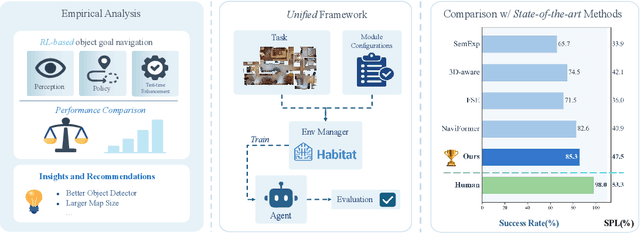
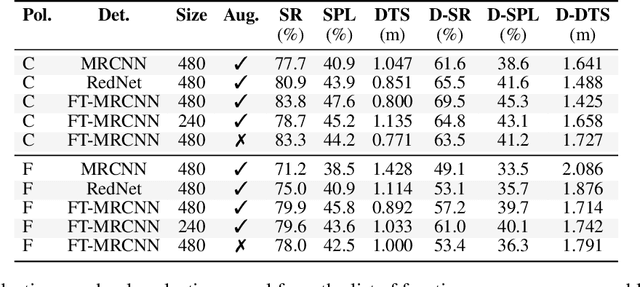
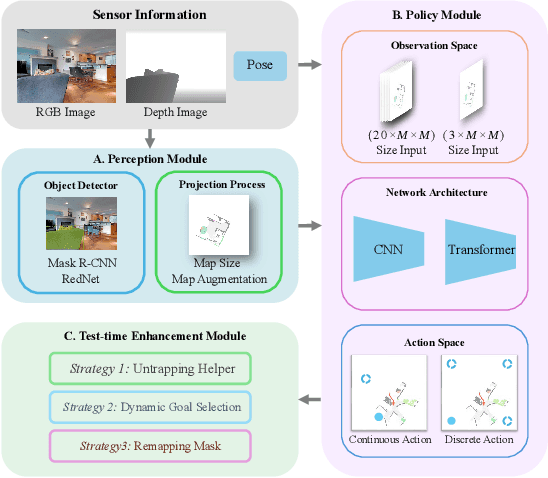

Abstract:Object-Goal Navigation (ObjectNav) is a critical component toward deploying mobile robots in everyday, uncontrolled environments such as homes, schools, and workplaces. In this context, a robot must locate target objects in previously unseen environments using only its onboard perception. Success requires the integration of semantic understanding, spatial reasoning, and long-horizon planning, which is a combination that remains extremely challenging. While reinforcement learning (RL) has become the dominant paradigm, progress has spanned a wide range of design choices, yet the field still lacks a unifying analysis to determine which components truly drive performance. In this work, we conduct a large-scale empirical study of modular RL-based ObjectNav systems, decomposing them into three key components: perception, policy, and test-time enhancement. Through extensive controlled experiments, we isolate the contribution of each and uncover clear trends: perception quality and test-time strategies are decisive drivers of performance, whereas policy improvements with current methods yield only marginal gains. Building on these insights, we propose practical design guidelines and demonstrate an enhanced modular system that surpasses State-of-the-Art (SotA) methods by 6.6% on SPL and by a 2.7% success rate. We also introduce a human baseline under identical conditions, where experts achieve an average 98% success, underscoring the gap between RL agents and human-level navigation. Our study not only sets the SotA performance but also provides principled guidance for future ObjectNav development and evaluation.
Benchmarking Egocentric Visual-Inertial SLAM at City Scale
Sep 30, 2025Abstract:Precise 6-DoF simultaneous localization and mapping (SLAM) from onboard sensors is critical for wearable devices capturing egocentric data, which exhibits specific challenges, such as a wider diversity of motions and viewpoints, prevalent dynamic visual content, or long sessions affected by time-varying sensor calibration. While recent progress on SLAM has been swift, academic research is still driven by benchmarks that do not reflect these challenges or do not offer sufficiently accurate ground truth poses. In this paper, we introduce a new dataset and benchmark for visual-inertial SLAM with egocentric, multi-modal data. We record hours and kilometers of trajectories through a city center with glasses-like devices equipped with various sensors. We leverage surveying tools to obtain control points as indirect pose annotations that are metric, centimeter-accurate, and available at city scale. This makes it possible to evaluate extreme trajectories that involve walking at night or traveling in a vehicle. We show that state-of-the-art systems developed by academia are not robust to these challenges and we identify components that are responsible for this. In addition, we design tracks with different levels of difficulty to ease in-depth analysis and evaluation of less mature approaches. The dataset and benchmark are available at https://www.lamaria.ethz.ch.
Lightweight and Accurate Multi-View Stereo with Confidence-Aware Diffusion Model
Sep 18, 2025Abstract:To reconstruct the 3D geometry from calibrated images, learning-based multi-view stereo (MVS) methods typically perform multi-view depth estimation and then fuse depth maps into a mesh or point cloud. To improve the computational efficiency, many methods initialize a coarse depth map and then gradually refine it in higher resolutions. Recently, diffusion models achieve great success in generation tasks. Starting from a random noise, diffusion models gradually recover the sample with an iterative denoising process. In this paper, we propose a novel MVS framework, which introduces diffusion models in MVS. Specifically, we formulate depth refinement as a conditional diffusion process. Considering the discriminative characteristic of depth estimation, we design a condition encoder to guide the diffusion process. To improve efficiency, we propose a novel diffusion network combining lightweight 2D U-Net and convolutional GRU. Moreover, we propose a novel confidence-based sampling strategy to adaptively sample depth hypotheses based on the confidence estimated by diffusion model. Based on our novel MVS framework, we propose two novel MVS methods, DiffMVS and CasDiffMVS. DiffMVS achieves competitive performance with state-of-the-art efficiency in run-time and GPU memory. CasDiffMVS achieves state-of-the-art performance on DTU, Tanks & Temples and ETH3D. Code is available at: https://github.com/cvg/diffmvs.
MCGS-SLAM: A Multi-Camera SLAM Framework Using Gaussian Splatting for High-Fidelity Mapping
Sep 17, 2025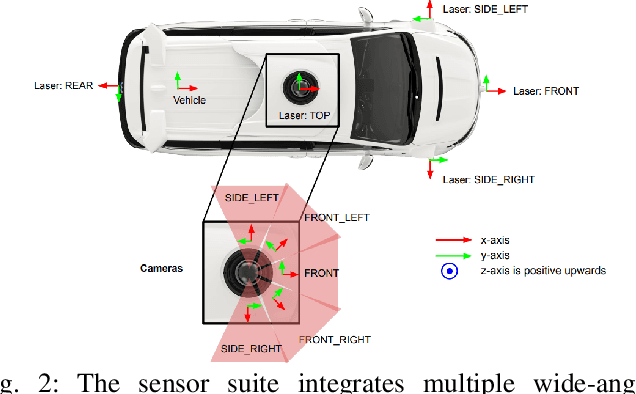
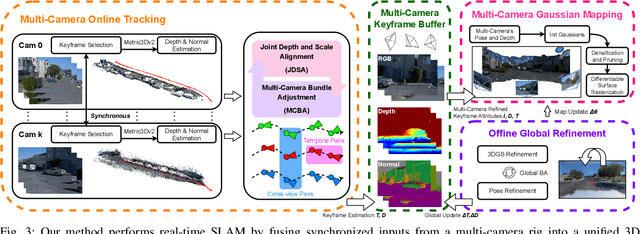
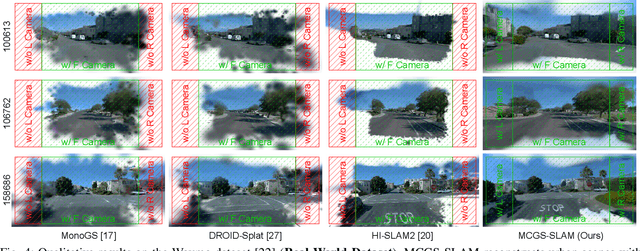

Abstract:Recent progress in dense SLAM has primarily targeted monocular setups, often at the expense of robustness and geometric coverage. We present MCGS-SLAM, the first purely RGB-based multi-camera SLAM system built on 3D Gaussian Splatting (3DGS). Unlike prior methods relying on sparse maps or inertial data, MCGS-SLAM fuses dense RGB inputs from multiple viewpoints into a unified, continuously optimized Gaussian map. A multi-camera bundle adjustment (MCBA) jointly refines poses and depths via dense photometric and geometric residuals, while a scale consistency module enforces metric alignment across views using low-rank priors. The system supports RGB input and maintains real-time performance at large scale. Experiments on synthetic and real-world datasets show that MCGS-SLAM consistently yields accurate trajectories and photorealistic reconstructions, usually outperforming monocular baselines. Notably, the wide field of view from multi-camera input enables reconstruction of side-view regions that monocular setups miss, critical for safe autonomous operation. These results highlight the promise of multi-camera Gaussian Splatting SLAM for high-fidelity mapping in robotics and autonomous driving.
ActLoc: Learning to Localize on the Move via Active Viewpoint Selection
Aug 28, 2025Abstract:Reliable localization is critical for robot navigation, yet most existing systems implicitly assume that all viewing directions at a location are equally informative. In practice, localization becomes unreliable when the robot observes unmapped, ambiguous, or uninformative regions. To address this, we present ActLoc, an active viewpoint-aware planning framework for enhancing localization accuracy for general robot navigation tasks. At its core, ActLoc employs a largescale trained attention-based model for viewpoint selection. The model encodes a metric map and the camera poses used during map construction, and predicts localization accuracy across yaw and pitch directions at arbitrary 3D locations. These per-point accuracy distributions are incorporated into a path planner, enabling the robot to actively select camera orientations that maximize localization robustness while respecting task and motion constraints. ActLoc achieves stateof-the-art results on single-viewpoint selection and generalizes effectively to fulltrajectory planning. Its modular design makes it readily applicable to diverse robot navigation and inspection tasks.
 Add to Chrome
Add to Chrome Add to Firefox
Add to Firefox Add to Edge
Add to Edge